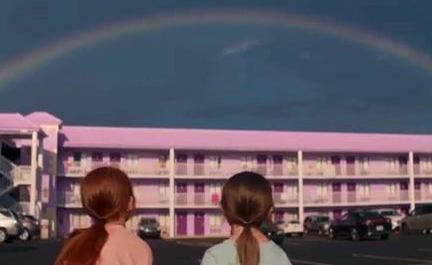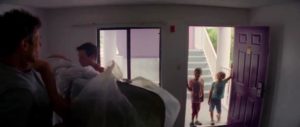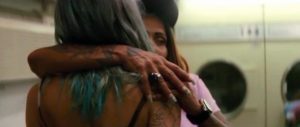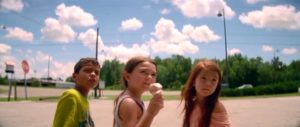There was a moment shortly after finishing my latest viewing of The Florida Project (the third of what will be many to come) when I felt I had really gotten my finger on the right word to describe it. With a ridiculously self-satisfied grin on my face, I scrawled down the words “magical neorealism”. It was a portmanteau of neorealism and magical realism and it felt right in the moment. I would still confidently say that the neorealist tag fits The Florida Project like a glove. Neorealism descends from Italian neorealism, the cinematic style that developed in Italy after World War II, famously advanced by directors like Vittorio Di Sica (Bicycle Thieves), Roberto Rosselini (Rome Open City), and Federico Fellini (in 1950s masterworks like La Strada, before he was anointed with the adjective Felliniesque, which, in its carnivalesque grandiosity, is about as far from neorealism as film gets). Neorealist films famously present the economically downtrodden of society with stark clarity and they tend to draw added authenticity from the use of nonprofessional actors, which accentuates the reality of the films by removing the comforting familiarity of established stars. Bicycle Thieves famously helped cement this facet of neorealism when Di Sica ignored Hollywood’s pleas to use megastar Cary Grant and opted to cast a Roman factory worker with no film resume whatsoever. Neorealism fits The Florida Project, which focuses on people living on the economic fringe and almost exclusively features performers who are nonprofessionals, or who are at least untested in screen acting. The magical realist tag is one I feel less confident about the more I think about it. Unlike recent magical realist films like Pan’s Labyrinth and Beasts of the Southern Wild, there is nothing truly supernatural or fantastical in The Florida Project. The stuff of fairytale never really breaks us away from the film’s stark, impoverished realities. There are no minotaurs or mystical riddles to solve or magical curses to lift or mythical beasts roaming the landscape. I confess that my little portmanteau is probably, technically inaccurate, but it still feels right to me. There is never a moment of The Florida Project where we truly escape financially depressed Kissimee, Florida, with its myriad low-rent motels, sprawling strip malls, and blighted condominiums, but somehow an aura of strange, uneasy magic hangs over it all. This is maybe the major miracle of Sean Baker’s ingenious, transporting, and shattering third film. It taps into magical realism’s power to comment upon and augment real life without ever retreating into literal fantasy. It is a film about bleak social conditions that finds hope and relief from those conditions, not by poofing them away but by staring ever more intently and deeply at them.

The Florida Project is an ensemble film in some ways with its teeming, perfectly cast tapestry of untrained performers. The only trained exceptions in the cast are veteran Willem Dafoe (in what I am ready to call the finest performance of his obviously esteemed career) and young, ubiquitous Caleb Landry Jones (capping off an impressive 2017 trifecta, after performances in Get Out and Three Billboards Outside Ebbing, Missouri). The first of many miracles of the film is how everyone (inexperienced Floridians, Instagram stars, and high-pedigree thespians alike) blends seamlessly into the same utterly organic whole. Baker makes the rundown motels of Kissimee, Florida bustle with rich, subtle lives. Still, as full of believable people as this world is, the film’s arc truly belongs to two great female characters. The first is Halley (Instagram celebrity Bria Vinaite, in a performance with some detractors, but that I find endlessly powerful in its oscillations between frightened vulnerability and loud, performantive snideness). Halley is an unemployed mother taking on the odd stripper job and illegally selling wholesale perfume to tourists to just barely afford her 30-dollar-per-night motel rent. The other main character, and I would say the film’s unquestionable lead, is Halley’s daughter Moonee, an imaginative, energetic, and altogether unruly six-year old girl. Moonee spends her carefree summer days (likely the last before the school system reins her in) bounding about Kissimee’s overgrown fields, vacant buildings, and parking lots as if they were an enchanted wilderness. The most important, mostly implicit detail of Moonee’s ramshackle world is that it sits on the very furthest outskirts of Walt Disney World. While it is never mentioned in the film, “The Florida Project” was Walt Disney’s covert working title for the park when it was being developed. The setting of The Florida Project is removed from all the luxury and privilege of the Magic Kingdom, yet close enough to it to still exist very much in its shadow. Kissimee is littered with perpetual reminders of the better life just out of view. Cheap outlet stores promise Disney-branded swag. Halley and Moonee’s regular trips to sell fragrances at the nearby Marriott resort takes them along a road that has been named Seven Dwarfs Lane. At one point, a pair of rich Brazilian newlyweds arrive at Moonee’s little motel, The Magic Castle, in the middle of the night, shocked and mortified to find that this fleabag establishment is in no way a Disney property. The Magic Castle’s most steadfast guardian is its manager, Bobby (the aforementioned, heartbreakingly splendid Dafoe), who not only tends to routine maintenance and touches up its walls with fresh coats of gaudy lavender paint, but also acts as a firm, gentle overseer of the motel’s residents. As much as anything that happens in its lyrical, sometimes heartrending plot, The Florida Project is about the Magic Castle as its own small world of kinship, stalled dreams, fragile hope, and wonder. The idea of this rundown “magic castle” lying just outside the view of so many Disney dream vacationers is something of a stinging social critique, but there is nothing cynical in Baker’s unsparing but loving depiction of this tiny realm and its people. The film is in many ways about Moonee’s childlike ability to see genuine beauty in such a tacky, impoverished place, but Baker sees that beauty himself and wants us to see it too. He presents the sadness and strife of these poor spaces with frankness but The Florida Project is not an act of miserablist wallowing. It is a fond embrace extended to those underseen and barely hanging on in this world of ours. In its radiant love for these people, even for a stubbornly self-destructive soul like Halley, The Florida Project is not simply a very empathetic film. It is pure, undiluted empathy rendered cinematic.
To some extent, The Florida Project’s neorealist accomplishments are its least outwardly impressive, simply because of how neatly they fit with past examples of the genre. This is a film about living with the daily drudgery and minutiae of economic strain: scrounging for work, providing for a child, feeding oneself, and coming up with rent. In the tradition of so many past neorealist masterpieces, it is about painting a realistic and suitably sober portrait of a dire situation, in which every misguided decision and impulsive misstep threatens to compound hardship and send it careening toward disaster. Baker presents these rough circumstances candidly. He never allows us to be entirely ignorant of the desperation that hangs over this land. And yet, without cheating, he finds a way to make it all feel lively, engaging and humanistic. He comes to rely partially on Moonee’s vivacity and rambunctious spirit to provide a kind of salve for the hardship. But it should be said that, even if The Florida Project were solely a work of austere neorealism, it would be a particularly humane and emotionally nuanced version of the genre. To put it another way, The Florida Project does not have to become a dichotomy between crushing poverty and the childlike ability to find escape in naivete and imagination. The reason The Florida Project does not need to retreat into literal magical realism, into the refuge of pure fantasy, is that even the purely adult parts of Baker’s world hum with a sense of humor and life. In a way that never minimizes the economic weight they are experiencing, Baker draws these characters with joyful color and unmistakable affection. These are people living at the subsistence level, but Baker finds spontaneity and wit in their interactions. The Florida Project’s adult characters are weathered but not defeated by this bare bones existence. There is a ragged joy and to these characters, and it keeps the spectres of cheap bathos and exploitation at bay. Baker is not gawking at these fragile lives. The Florida Project is the furthest thing from so-called poverty porn. These people are not presented to be pitied or to become easy stand-ins in a lecture about America’s poverty problem. The director shows us these souls with no ulterior motive outside of basic compassion and curiosity. He shows them because they represent real human beings living out in the world, in Kissimee-like towns across the country, and their stories deserve to be heard. Even an aggravatingly immature woman like Halley is rendered with depth and a stubborn kind of nobility. These lives are not easy, but Baker does not show them to titillate us or to bolster a post-recession sermon. They exist because they exist. Understanding and really feeling the unvarnished beauty of that fact is quite possibly the most important element to grasping The Florida Project’s overwhelming emotional power. It is a litmus test for our compassion toward human beings.
That said, Baker knows that, even with all the empathy and positive thinking in the world, the austerity of this milieu could be a painful thing to look at for too long all at once. Watching The Florida Project can be a bit like staring at the Sun: glorious, dazzling, and also searing. Baker has no intention of looking away from the poverty and pressure (for the film, with one possible exception, never truly looks away). But he is interested in thinking about how a person, a child in particular, might find some hopeful respite within this place. This is where Moonee comes in, in all her exuberant, cavalier, infectiously profane glory. I could spend entire paragraphs on Moonee’s exquisite characterization and the miracle of Brooklynn Prince’s performance, which, like the film around it, perches effortlessly between neorealist naturalism and grand, heightened emotions. I could spend a full additional paragraph on the astonishing feat of presenting yet another child’s eye view of poverty without ever tipping into the most queasy and problematic kind of preciousness. What Sean Baker and Brooklynn Prince have given us is an almost impossibly candid picture of unruly childhood glee; one which marvels at youth’s optimism and unflagging spirit, but does not pretend that children are untouched or unfazed by the real world around them. It also remembers that children are people, with all the imperfection that implies. Moonee is a reminder that children can be vulgar, myopically self-centered little marauders. She is an adorable, bracingly funny, and very sympathetic character, but she is also a gallingly unrestrained force of chaos. For as much as Moonee is out to steal our hearts away, she is also the kind of child who would probably make the average person blanch if they had to share a city bus with her. In the first minute we spend with Moonee, she has already spat upon the sweet, shy little girl who will become her best friend and is cackling invincibly at the gobsmacked grandmother trying to reprimand her. Her petite pixie exterior seems possessed by the arrogant, braying spirit of some 1920s Chicago gangster. But we do come to love her, and it is through her eyes that this rundown world comes to take on its own jagged kind of lustre. Let me say right here that, for a low-budget film whose central setting is an economically ravaged city, The Florida Project feels lustrous and luminous. This place is a golden-hued frontier to Moonee and her friends, and Baker’s film glows with admiration for their hardy spirit; for the childlike ability to find beauty and adventure anywhere. He is not interested in defanging Moonee or softening her feral fallibility, and he does not use her rosy perspective to smother his film’s hard truths. Even at its sweetest, most purely awed moments, when Moonee is shepherding us through the Magic Castle like a giddy tour guide, shafts of painful, glaring reality pierce the optimistic facade. In that way, The Florida Project becomes the rare film to present a hardscrabble childhood in a way that is both loving and honest.
I think the guiding principle behind Baker’s approach is just to not shut out any emotional truth. Wonder and innocence do not make poverty and strife go away, and economic depression does not kill all optimism. Baker respects his audience enough to show this world from a wide array of angles and to let us decide how we feel about it. There is no right or wrong answer, but I think Baker wants us to feel as elated and devastated as possible all at the same time. For my part, no film in 2017 made me feel more hopeful and more shattered; more in love with humanity and more thoroughly spent with the full emotional toll of being a person. For what at first looks like a spare, realistic indie drama, The Florida Project is bursting at the seams with every possible emotion. Baker has taken a no-frills setting and a minimal budget and created an absolute kaleidoscope of feeling. This is a film that invites you to bring your own empathy and human outlook to it. Still, I do think Baker may at least offer a clue to his own feelings. I believe that clue comes in the form of Willem Dafoe’s gruff, kind, and heartbreakingly concerned Bobby. The experience of The Florida Project lies somewhere between a frail hope for people, a protective fondness toward childhood’s guileless innocence, and a knowing sadness that life can be unforgiving. Willem Dafoe lets that entire emotional tug-of-war play out beautifully, quietly, and powerfully across the face of this good-natured, fallible handyman. The moment where Bobby intercepts a pedophile wandering onto the motel grounds is simultaneously one of 2017’s most chilling and heartwarming moments. If The Florida Project is about letting some hope survive in the harshest of landscapes, Bobby is the character trying to shelter that hope; cupping his calloused hand around it like a windblown candle. He is the good king of this Magic Castle, but the withering emotional punch of the character comes from how Dafoe lets us catch glimpses of Bobby’s weary, frustrated impotence. Like Baker himself, Bobby is a man who wants to help and protect the denizens of his small, beleaguered, unseen corner of the world. But even in a place this tiny and insular, there are limits to how much any one person can do for another. The Florida Project is about the tremendous power we have to care for each other, to reach out to each other, and to be of good to each other. And it is also about the wrenching sadness that comes from remembering we cannot keep all the pain out. Even the most dedicated handyperson can never fix everything. The children may see Bobby as the all-powerful, benevolent wonderworker of this Castle, but Dafoe’s tired eyes betray the truth to us. We are not in the realm of magical realism. There are no wizards in this place. Only human beings doing all they possibly can and making torn, conflicted peace with where their power stops.
There is no real magic in Kissimee, Florida and the fake magic that Disney built decades ago is too far away to be visible on the horizon. The spires of Sleeping Beauty’s castle are far removed from this crumbling place. Nothing about this world could ever be classified as a fairytale. But what Baker, his actors, and his team manage to do is more wondrous to me than anything the Disney experience could provide. They make this barren land of strip malls and dilapidated medical clinics glow. They do all of this with nothing more than a contagious affection for humankind at its best and a non-judgmental compassion for people at their worst. A lot of The Florida Project involves watching people make hard, sometimes cruel choices and rash, foolhardy decisions. Sometimes the consequences of those decisions are so harsh they take your breath away. This is a world where some poor soul is always teetering on the precipice of ruin and loss. It is a world of prostitution, bedbugs, and petty crime. A world where ugly brawls sometimes break out in the parking lots, where only one of the motel washing machines works anymore, and where the closest you’ll ever get to a fancy vacation is flipping off the resort helicopters as they buzz by loaded with the more fortunate. This is a hard world and I left it in gutted silence. But somewhere beneath that, I also felt a strange kind of enchantment that no amount of misery could erase. The film left me with a strange, tingly feeling. It was something halfway between my earliest Christmas memory and my first underage tequila buzz. It felt sweet and pure, and also a little sad and seedy. It felt like magic, but borne out of something honest, painful and utterly real. I still can’t put my finger on what that feeling is. I’ll call it empathy until I find a better word.















